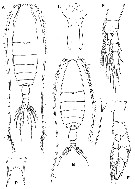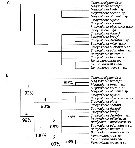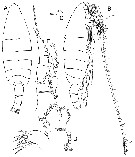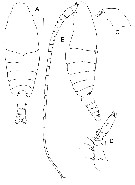|
|
 |
|
Calanoida ( Ordre ) |
|
|
|
Calanoidea ( Superfamille ) |
|
|
| |
| | | |
| Megacalanidae Sewell, 1947 ( Calanoidea ) | | Ref.: | Sewell, 1947 (p.20, G. & spp. Key ); Farran & Vervoort, 1951 a (n°33, p.3); Johnson, 1958 a (p.257); Vervoort, 1963 b (p.85, Rev.); Andronov, 1974 a (p.1005); Razouls, 1982 (p.84); Bowman & Abele, 1982 (p.10); Brodsky & al., 1983 (p.142, 146, 190); Mauchline, 1988 (p.718: cuticular pores); Nishida, 1989 (p.175); Bradford-Grieve, 1994 (p.17, Def.); Michel, 1994 (p.175, Genera and spp Key); Chihara & Murano, 1997 (p.834); Barthélémy, 1999 a (p.30); Bradford-Grieve & al., 1999 (p.877, 902, 904, 905, Genera Key); Ohtsuka & Huys, 2001 (p.445, 461); Boxshall & Halsey, 2004 (p.13: 49; 139: Def.; p.140: Genera Key); Vives & Shmeleva, 2007 (p.909, Genera Key); Bradford-Grieve & Ahyong, 2010 (p.287: Rem., phylogeny); Blanco-Bercial & al., 2011 (p.103, Table 1, Fig.2, 3, 4, molecular biology, phylogeny); Bradford-Grieve & al., 2017 (p.1-183: familie's revision; Diagnosis: p.25-26, molecular biology, phylogeny); Laakmann & al., 2019 (p.330, fig. 2, 3, phylogenetic relationships)
Bradford-Grieve J.M., (2002 onwards). Key to calanoid copepod families. Version 1 : 2 oct 2002. http://www.crustacea.net/crustace/calanoida/index.htm  | | Rem.: | Genre type: Megacalanus Wolfenden, 1904. 4 G.: Bathycalanus, Bradycalanus, Megacalanus, Elenacalanus. |  Issued from : G.A. Boxshall & S.H. Halsey in An Introduction to Copepod Diversity. The Ray Society, 2004, No 166, Part. I. [p.139]. Armature formula of swimming legs P1 to P4. Female P5, biramous with 2-segmented protopod and 3-segmented rami. Male P5 slightly asymmetrical; both biramous with 2-segmented protopod and 3-segmented rami; inner seta of 2nd exopodal segment (* in formula) modified, present on lelft leg only. Eggs released into water. |
 Issued from : G.A. Boxshall & S.H. Halsey in An Introduction to Copepod Diversity. The Ray Society, 2004, No 166, Part. I. [p.141, Fig.29]. Megacalanidae. A, Bradycalanus sarsi (as Megacalanus princeps) habitus female; B, Bradycalanus richardi habitus male; C, rostral filaments; D, Megacalanus princeps (as Megacalanus longicornis, rostral filaments; E, P1; F, P5.
[After Sars, 1924]. |
 Issued from : J.M. Bradford-Grieve, L. Blanco-Bercial & G.A. Boxshall in Zootaxa, 2017, 4229 (1). [p.26]. Setal formula of swimming legs P1 to P5 female and male. |
 Issued from : J.M. Bradford-Grieve, L. Blanco-Bercial & G.A. Boxshall in Zootaxa, 2017, 4229 (1). [p.160, Fig. 112]. Strict consensus (A), 50% majority-rule (B) trees, of 84 trees, length 102, consistency index ( CI) = 0.75, retention index ( RI) = 0.90. After one round of successive rewighting (50% majority rule of 12 trees), the topology of tree 1 is same as unweighted 50% majority rule tree (B). The trees are rooted to the outgroup calanus helgolandicus. After Bradford-Grieve & al. (2014), the phylogenetic hypothesis concerning calanoid coppepod families has the Calanidae as sister to the Megacalanidae.. The exemplar chosen is Calanus helgolandicus because this is one of the taxa used in the outgroup for the genetic analysis to realyse comparison with the cladistic analysis. Clade number above the line and bootstrap support see author's text. Among characters with a high consistency index ( RC) are several that are recognised by the authors as defining the genera. For example, the terminal setae of Mx2: curled completely on themselves) defines Bathycalanus; outer spines of P1 exopod segments 1-3: present and P1 basis anterodistal hook-like process: present define Megacalanus; proximal inner seta of endopod segment 2 of Mx2: vestigial with oval base defines Bradycalanus; outer distal spines of P1 exopod segments 1 and 2: absent denine Bathycalanus; and a number of characters define the remamed genus Elenacalanus. In tree B, 1: Megacalanus (Clade 1) is sister to the remaining members of the family. It is united by two unambiguous, unique characters: A1 ancestral segments XIV-XVII with ventral surface with row of teeth and P1 basis with hook-like process. Clade 2 is united by four unique, unambiguous character changes that are uniform in the tree: On Mx1, basal endite 1 with 2 setae and endopod segment 3 lacks seta 7. On Mx2, the endopod setae do not have sparse auxiliary spinules and endopod segment 1 smallest setae are vestigial. Several other characters change unambiguously on a branch, change above the node in the tree, but are uniform outside the branch: an aesthetasc is present on female A1 ancestral segment XXIII. A2 ancestral segment IV seta is short. On Md endopod segment 1 and 2 the surface setae are vestigial. On Mx1, endopod segment 2 has 2 setae. On Mxp endopod segment 3, setae 2 and 3 are reduced in size and on endopod segment 5 iinner seta 2 is reduced in size. Clade 2 divides into two sister clades - 3 and 4.: Clade 3 ( Bradycalanus) is united by two unique unambiguous characters: Mx2 coxal epipodite seta vestigial and on endopod segment 2 the distal inner seta convex border is naked. Clade 4 is united by three unambiguous, unique changes uniform: there is a macula cribrosa adjacent to the hair sensillum on ancestral segment V of the female A1; the setae of praecoxal endites 1 and 2 and coxal endite 1 of Mx2 are without sparse auxiliary spinules and there is no outer distal spine on exopod segments 1 and 2 of P1. Two characters that change unambiguously on its branch but are homoplasious in the tree are: on Mx1, absence of the 2 distalmost setae on posteriorsurface and presence of 2 setae on basal endite 2. Within Clade 4 there are two sister clades (5 and 6) with variable bootstrap support: Clade 5 ( Bathycalanus) is united by two unambiguous, unique changes uniform: the hair sensillum on ancestral segment IV is absent and P1 exopod segment 3 is without a proximal outer spine. One character changes but not outside: anterior head with 2 spines and one character is homoplasious* outside: anterior head is decorated in dorsal view. Clade 6 (the renamed genus Elenacalanus nom. nov.) is united by eleven unambiguous unique changes uniform: on Md endopod segment 1, the distal and proximal setae are absent; endopod segment 2 both surface setae are absent; on Mx1 endopod segment 3, seta 6 is absent; on Mxp, setae 2, 3 and 4 of endopod segment 3 are absent; seta 3 of endopod segment 4 is absent and inner seta 2 of endopod segment 5 and the outer border seta are both absent. Three other characters are homoplasious* outside and one character that is homoplasious also unite this clade. Generally the present morphological data set is insufficiebnt to resolve most relationships at the species level. Of course, the necessity of the molecular analysis (See pp. 22-25). *: Structural resemblance due to parallelism or convergent evolution rather than to common ancestry | | | | | (1) Bathycalanus Sars, 1905 | |
| | Syn.: | Heterocalanus Wolfenden, 1906 (p.26); 1911 (p.201) | | Ref.: | Sars, 1905 b (p.8); 1925 (p.16); Wolfenden, 1911 (p.198); Sars, 1920 c (p.1); 1925 (p.16); Sewell, 1929 (p.30); Rose, 1929 (p.11, Rem.); 1933 a (p.65); Farran, 1939 (p.359); Vervoort, 1946 (p.63); Sewell, 1947 (p.32); Brodsky, 1950 (1967) (p.97); Farran & Vervoort, 1951 a (n°33, p.3); Tanaka, 1956 (p.264); Vervoort, 1963 b (p.85); Razouls, 1982 (p.86); Brodsky & al., 1983 (p.193, spp. Key); Mauchline, 1988 (p.718); Razouls, 1993 (p.308); Bradford-Grieve, 1994 (p.18, Def.); Michel, 1994 (p.188, spp. Key); Chihara & Murano, 1997 (p.834); Mauchline, 1998 (p.71); Boxshall & Halsey, 2004 (p.140); Bradford-Grieve & al., 2017 (p.74, Redefinition., phylogeny, species key F & M: p.169) | | Rem.: | type: Bathycalanus richardi Sars,1905. 10 spp. + 1 uncertained | | Remarques sur les dimensions et le sex-ratio: | | The mean female size is 10.792 mm. (n = 17; SD = 1.584), and the mean male size is 9.344 mm. (n = 9, SD = 1.843). The size ratio (male: female) is approximately 0.887. |  Issued from : J.M. Bradford-Grieve, L. Blanco-Bercial & G.A. Boxshall in Zootexa, 2017, 4229 (1). [p.75, 76]/ Setal formula of swimming legs P1 to P5 (except from leg 1 exopod in Bathycalanus richardi). Roman numerals indicate spines, Arabic numerals setae, outer border setation listed to left in each group separated by ';' |
 Issued from : J.M. Bradford-Grieve, L. Blanco-Bercial & G.A. Boxshall in Zootexa, 2017, 4229 (1). [p.77, Fig.41] Type species. Bathycalanus richardi (Sars, 1905) female:
A-B, habitus (dorsal and lateral, respectively); C, forehead (lateral); D, Mx1; E, P1 (anterior view). Scale bars represent 1.0 mm on figures A, B; 0.1 mm on figures C, D, E. |
 Issued from : J.M. Bradford-Grieve, L. Blanco-Bercial & G.A. Boxshall in Zootexa, 2017, 4229 (1). [p. 170, Table 18]. Setation of selected parts of Mx1 of bathycalanus. |
 Issued from : J.M. Bradford-Grieve, L. Blanco-Bercial & G.A. Boxshall in Zootexa, 2017, 4229 (1). [p.171, Table 19] . Setation of selected parts of the A2 and Md. Comparison with Calanus helgolandicus. |
 Issued from : J.M. Bradford-Grieve, L. Blanco-Bercial & G.A. Boxshall in Zootexa, 2017, 4229 (1). [p.172, Table 20] . Setation of selected parts of the Mx1. Comparison with Calanus helgolandicus. |
 Issued from : J.M. Bradford-Grieve, L. Blanco-Bercial & G.A. Boxshall in Zootexa, 2017, 4229 (1). [p.173, Table 21] . Setation of selected parts of the Mxp and P1. Comparison with Calanus helgolandicus. | | | | | (2) Bradycalanus A. Scott, 1909 | |
| | Ref.: | A. Scott, 1909 (p.14); Farran, 1939 (p.359); Vervoort, 1946 (p.47, 48, 49); Sewell, 1947 (p.27); Farran & Vervoort, 1951 a (n°33, p.3); Tanaka, 1956 (p.264); Vervoort, 1963 b (p.85); Owre & Foyo, 1964 (p.343, Rem.); 1967 (p.34); Razouls, 1982 (p.88); Brodsky & al., 1983 (p.198); Mauchline, 1988 (p.718); Razouls, 1993 (p.308); Bradford-Grieve, 1994 (p.20, Def.); Michel, 1994 (p.188, spp. Key); Mauchline, 1998 (p.71); Bradford-Grieve & al., 1999 (p.905, 906: spp. Key); Boxshall & Halsey, 2004 (p.140); Vives & Shmeleva, 2007 (p.911); Bradford-Grieve & al., 2017 (p.51, Diagnosis, Redefinition., phylogeny, species key: p.169) | | Rem.: | Type: Bradycalanus typicus A. Scott,1909. 4 spp. (dont 1 douteuse).
Pour Owre & Foyo (1964) ce genre est synonyme de Megacalanus , position qui sera abandonnée par les auteurs en 1967. | | Remarques sur les dimensions et le sex-ratio: | | The mean female body size is 13.063 m (n = 8, SD = 2.610) and the mean male body size is 10.233 mm (n = 3; SD = 3.427). The length ratio male : female is approximately 0.8 . Sex ratio 2 but probably = 1owing to the fact that the abyssal situation and the paucity individuals catched. |  Issued from : J.M. Bradford-Grieve, L. Blanco-Bercial & G.A. Boxshall in Zootaxa, 2017, 4229 (1). [p.53]. Setal formula of swimming legs P1 to P5 female and male. Nota: - P5 female with outer distal corner of endopod segment 1 rounded; pore openings on anterior surface at base of outer border spines. - P5 male almost symmetrical apart from specialised seta on inner distal border of left exopod segment 2 and asymmetrically inserted single seta on inner border of exopod segment 3 (these homologous with terminal spine of female. Left P5 exopod segment 2, specialised seta evenly tapering bearing dens longitudinal row of long setules extending onto basal part; outer proximal border bearing small tapering lobe. Outer distal corner of endopod segment 1 rounded. Pore openings on anterior surface at base of outer spines. Basis inner distal border with patch of elongate setules. |
 Issued from : J.M. Bradford-Grieve, L. Blanco-Bercial & G.A. Boxshall in Zootaxa, 2017, 4229 (1). [p.60, Fig.30]. Type species: Bradycalanus typicus A. Scott, 1909. Female: A-B, habitus (dorsal and lateral, respectively); C, lateral view of anterior head; D, exopod of A2. Scale bars: 1.0 mm (A, B); 0.1 mm (C, D) |
 Issued from : J.M. Bradford-Grieve, L. Blanco-Bercial & G.A. Boxshall in Zootexa, 2017, 4229 (1). [p.171, Table 19] . Setation of selected parts of the A2 and Md. Comparison with Calanus helgolandicus. |
 Issued from : J.M. Bradford-Grieve, L. Blanco-Bercial & G.A. Boxshall in Zootexa, 2017, 4229 (1). [p.172, Table 20] . Setation of selected parts of the Mx1. Comparison with Calanus helgolandicus. |
 Issued from : J.M. Bradford-Grieve, L. Blanco-Bercial & G.A. Boxshall in Zootexa, 2017, 4229 (1). [p.173, Table 21] . Setation of selected parts of the Mxp and P1. Comparison with Calanus helgolandicus. | | | | | (3) Elenacalanus Bradford-Grieve, Blanco-Bercial & Boxshall, 2017 | |
| | Ref.: | Bradford & al. (2017, p.129, Def.) | | Rem.: | Espèce type: Heterocalanus medius Wolfenden, 1906. Total: 5 spp. | | Remarques sur les dimensions et le sex-ratio: | | The mean body size female: 14.372 mm (n = 9; SD = 2.1256) and male: 11.433 mm (n = 3; SD = 2.1939). The length ratio male/female = 0.853 (n = 3; SD = 0.1225. Sex ratio female/male = 1.5 |  Issued from : J.M. Bradford-Grieve, L. Blanco-Bercial & G.A. Boxshall in Zootaxa, 2017, 4229 (1). [p.131]. Seral formula of swimming legs P1 to P5. Roman numerals indicates spines, Arabic numerals setae; outer border setation listed to left in each group separate by '';'' Nota:
- P5 female biramous, each ramus 3-segmented;
- P5 male almost symmetrical, apart from left exopodal segment 2 specialised seta on inner distal border, composed of 2 sections: basal part and 1 setulose, curved lash (or 2 equal lasghes in E. tageae). Exopodal segment 3 on both sides with analogue of terminal spine of female P5 located on distal inner border; on left exopodal segmentb 3 inner border lined with setules, right exopodal segment 3 naked or with patch of inner proximal setules (known from 3 species). |
 Issued from : J.M. Bradford-Grieve, L. Blanco-Bercial & G.A. Boxshall in Zootexa, 2017, 4229 (1). [p.171, Table 19] . Setation of selected parts of the A2 and Md. Comparison with Calanus helgolandicus. |
 Issued from : J.M. Bradford-Grieve, L. Blanco-Bercial & G.A. Boxshall in Zootexa, 2017, 4229 (1). [p.172, Table 20] . Setation of selected parts of the Mx1. Comparison with Calanus helgolandicus. |
 Issued from : J.M. Bradford-Grieve, L. Blanco-Bercial & G.A. Boxshall in Zootexa, 2017, 4229 (1). [p.173, Table 21] . Setation of selected parts of the Mxp and P1. Comparison with Calanus helgolandicus. | | | | | Heterocalanus Wolfenden, 1906 | |
| | Ref.: | Wolfenden, 1906 (p.26); 1911 (p.211); Farran, 1908 b (p.21); Vervoort, 1946 (p.63); 1963 b (p.85, Rem.); Razouls, 1982 (p.88) | | Rem.: | Cf. Bathycalanus | | | | | Ref.: | Sars, 1905 b (p.7); With, 1915 (p.36, clé G); Farran, 1939 (p.359, Rem.) | | Rem.: | Cf. Megacalanus | | | | (4) Megacalanus Wolfenden, 1904 | |
| | Syn.: | Macrocalanus Sars, 1905 b (p.7); With, 1915 (p.36)
? Pseudolovenula Marukawa, 1921 (p.13, figs.) | | Ref.: | Wolfenden, 1904 (p.112); 1905 a (p.1); van Breemen, 1908 a (p.13); A. Scott, 1909 (p.10); Wolfenden, 1911 (p.195); With, 1915 (p.40); Sars, 1925 (p.10, Rem.); Sewell, 1929 (p.27, Rem.); Wilson, 1932 a (p.26); Rose, 1933 a (p.63); Farran, 1939 (p.355, Rem.); Vervoort, 1946 (p.47, Rem.); Sewell, 1947 (p.20, Rem.); Farran & Vervoort, 1951 a (n°33, p.3); Tanaka, 1956 (p.262); Vervoort, 1963 b (p.85); Guérédrat, 1969 (p.67, Rem.); Razouls, 1982 (p.84); Brodsky & al., 1983 (p.191); Mauchline, 1988 (p.717); Razouls, 1993 (p.308); Bradford-Grieve, 1994 (p.17, Def.); Michel, 1994 (p.187, spp. Key); Chihara & Murano, 1997 (p.834); Mauchline, 1998 (p.71); Boxshall & Halsey, 2004 (p.140); Vives & Shmeleva, 2007 (p.911); Bradford-Grieve & al., 2017 (p.26, Redefinition., Diagnosis, phylogeny, species key F & M: p.168) | | Rem.: | type: Megacalanus princeps Wolfenden,1904. 4 spp. | | Remarques sur les dimensions et le sex-ratio: | | Mean body size female: 10.104 (n = 8; SD = 1.877) and male: 10.114 (n = 7, SD = 0.979. Length ratio male : female = 1.011 (n = 4, SD = 0.071). Sex ratio = 1. |  Issued from : J.M. Bradford-Grieve, L. Blanco-Bercial & G.A. Boxshall in Zootaxa, 2017, 4229 (1). [p.28, 29]. Seral formula of swimming legs P1 to P5. Roman numerals indicates spines, Arabic numerals setae; outer border setation listed to left in each group separate by '';''; Nota Female: P5 extending just beyond third free urosomite, with outer distal corner of endopod segment 1 rounded; pore openings on anterior surface at base of outer border spines; maculae cribrosae on anterior surface of basis near articulation with exopod segment 1, on endopod segment 2, and just proximal to pore on exopod segments 1-3. Nota Male: P5 almost symmetrical apart from specialised seta on inner distal border of left exopod segment 2 and asymmetrically inserted single spine on inner border of exopod segment 3 (homologous with terminal spine of female). Left P5 exopod segment 2, specialised seta composed of two sections: |
 Issued from : J.M. Bradford-Grieve, L. Blanco-Bercial & G.A. Boxshall in Zootexa, 2017, 4229 (1). [p.171, Table 19] . Setation of selected parts of the A2 and Md. Comparison with Calanus helgolandicus. |
 Issued from : J.M. Bradford-Grieve, L. Blanco-Bercial & G.A. Boxshall in Zootexa, 2017, 4229 (1). [p.172, Table 20] . Setation of selected parts of the Mx1. Comparison with Calanus helgolandicus. |
 Issued from : J.M. Bradford-Grieve, L. Blanco-Bercial & G.A. Boxshall in Zootexa, 2017, 4229 (1). [p.173, Table 21] . Setation of selected parts of the Mxp and P1. Comparison with Calanus helgolandicus. | | | | | | | | |
|
|
 Toute utilisation de ce site pour une publication sera mentionnée avec la référence suivante : Toute utilisation de ce site pour une publication sera mentionnée avec la référence suivante :
Razouls C., Desreumaux N., Kouwenberg J. et de Bovée F., 2005-2026. - Biodiversité des Copépodes planctoniques marins (morphologie, répartition géographique et données biologiques). Sorbonne Université, CNRS. Disponible sur http://copepodes.obs-banyuls.fr [Accédé le 05 janvier 2026] © copyright 2005-2026 Sorbonne Université, CNRS
|
|
 |
 |









